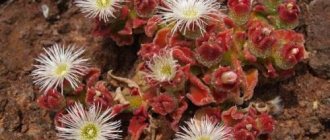The polyanthus rose is an unusually ornamental plant, capable of turning an ordinary garden into a fabulous one with its presence. In addition, these roses are unpretentious in care, which makes their cultivation possible even for novice gardeners. The plants have varied and very bright petal colors, which makes the garden area especially decorative and picturesque.
Moreover, the flowering of polyanthus roses is also quite long, which cannot but please the owners of summer cottages and garden plots. The plant is unpretentious and is quite suitable even for central Russia. In this article we will look at the features of growing polyanthus roses from seeds, and also learn how to care for this plant.
Rose Polyanthus or Angelica - growing from seeds at home
The polyanthus rose is an unusually ornamental plant, capable of turning an ordinary garden into a fabulous one with its presence.
In addition, these roses are unpretentious in care, which makes their cultivation possible even for novice gardeners. The plants have varied and very bright petal colors, which makes the garden area especially decorative and picturesque. Moreover, the flowering of polyanthus roses is also quite long, which cannot but please the owners of summer cottages and garden plots. The plant is unpretentious and is quite suitable even for central Russia. In this article we will look at the features of growing polyanthus roses from seeds, and also learn how to care for this plant.
Main characteristics
Polyantha roses bloom on all young shoots; it begins in mid-June and lasts until late autumn .
This type of plant tolerates winter cold very well if provided with proper shelter . Even if some shoots freeze, the bush quickly recovers and sends out new branches from the roots.
Another advantage of this subspecies is the presence of immunity to fungal diseases and the ability to grow in humid climates. Such shrubs take root very quickly.
Description
The polyanthus rose is notable for its abundant flowering, as well as the compactness of its bushes. It can be grown from seeds both in open ground and at home. It is interesting that in the first year of flowering, polyanthus roses are often not distinguished by the beauty of their buds. However, already in the second, and even more so in the third year, the flowers will become lush and luxurious, like on advertising postcards.
The plants are small in size - the polyanthus rose reaches only half a meter in height. Therefore, sometimes such a rose is also called miniature.
The buds of the polyanthus rose are double - that is, their petals are in several rows: this gives the plant a particularly pronounced decorative effect.
You should know that about 100 flowers can form on an adult bush in one season, which is quite a lot for such a small bush. The diameter of the flowers can be from 2 to 10 cm: they are collected in inflorescence groups of 4-10 copies.
The color of polyanthus rose petals is most often pink. But sometimes you can find red and white specimens. If the seller offers you to buy a yellow polyanthus rose, then know that this is a deception: this type of plant has not yet been bred. But how the Rumba Climbing Rose is planted and cared for can be found out from the contents in this article.
The aroma of this rose variety is very light, and sometimes completely absent.
Video of growing polyanthus roses from seeds:
Popular varieties
We invite you to get acquainted with brief descriptions and photos of polyanthus roses, which are well suited for growing in domestic gardens and summer cottages, as well as in pots:
Burkhard (Grumpy) – De Ruiter, Netherlands, 1956
The bushes of this reliable dwarf rose are very dense and compact - their height is only 30-40 cm. Ideal for small gardens and container plantings. The lack of aroma is compensated by the abundance of magnificent double flowers of miniature sizes (1.5-2 cm), which consist of approximately 16 petals, painted in bright and soft pink shades. The buds appear in dense, grape-like inflorescences. The plant does not lose its decorative appearance in rainy weather, but is moderately resistant to typical crop diseases. The variety is characterized by flowering throughout the season with short breaks.
The pink Burkhard (left) is the twin sister of the red Alberich (Happy), also bred in the Dutch nursery De Ruiter until 1954 (pictured on the right)
Harkovchanka (“Kharkovchanka”) – Z. K. Klimenko, NBS (Ukraine), 2014
The bushes are spreading, reaching a height of 70-110 cm, densely leafy. The foliage is leathery, light green in color. The flowers are double (on average 25 petals), cup-shaped, show the center when blooming, bright pink, small in size, up to 5 cm in diameter. The variety is valued not only for its beautiful appearance, but also for its delicate peach aroma. The flowering period is quite long, until mid-autumn.
Experts classify “Kharkovchanka” as a category of miniature and patio roses, recommended for forming groups, borders and trunks in the southern regions of Russia
Louis Bleriot (Lavender Meidiland, Meibivers) – Meilland International, France, 2006
The bush is spreading, reaches a height of 40-90 cm and a width of 70 to 150 cm, and is often used as a ground cover. Flowering is abundant, repeated, almost continuous throughout the season. The petals are a deep pink shade with a lavender underside as they fade and gradually become light pink. Flowers with a diameter of 4 to 6 cm, semi-double (on average 20 petals), collected in brushes of 3-5 pieces. The foliage is dark green with a glossy surface. The plant is little susceptible to fungal diseases.
Long-climbing bushes are great for creating picturesque borders or spectacular accents in flower beds.
Marjorie Fair (HARhero, Red Ballerina, Red Yesterday) – Harkness, UK, 1977
The bushes are highly branched from the base, densely leafy, reaching a height of 1.2-1.8 m with a width of up to 1.1-1.5 m. The leaves are small, light green, thin, matte. The plant is characterized by a dense crown and constantly produces new flowering shoots, which have climbing properties and, if supported, can be used for vertical gardening. Flowering is long, almost continuous, abundant even at the end of the season. The flowers are collected in lush inflorescences (up to 60 pcs.), have a weak aroma, tolerate wet weather well, but fade quite quickly in the hot sun. To maintain the neatness of the bush, it is recommended to remove fading specimens without waiting for the small red fruits to ripen. The plant is quite resistant to common crop diseases, and is rarely (under unfavorable conditions) affected by powdery mildew and black spot.
The flowers are small (2-3 cm in diameter), simple (consist of only 5 petals), but have an interesting two-color color: cherry-raspberry with a white “eye” in the center
Mörsjaroos – Johann Eifeld, Estonia, 1950
The compact bush reaches 50-60 cm in height, densely foliated. Flowers with a weak pleasant aroma, light pink, up to 5 cm in diameter, double, consisting of approximately 26 petals. The plant is winter-hardy, is immune to black spot, but in unfavorable conditions it exhibits average resistance to powdery mildew.
Mörsjaroos – “Bride's Rose” is characterized by long continuous flowering throughout the season
Orange Triumph – Wilhelm JH Kordes II, Germany, 1937
The bush is strong, branched, compact, reaching a height of 60 to 90 cm. The blooming buds are brightly colored: salmon-red with an orange tint. The flowers are double, cup-shaped, collected in brushes of 5-10 pieces. When fully bloomed, they have a diameter of 3-5 cm and have a subtle pleasant aroma. Flowering repeats in waves throughout the season.
Due to their bright colors, the flowers stand out effectively against the background of dense foliage.
Yesterday (RH F 263 B, Tapis d'Orient) – Harkness, UK, 1974
The bushes are compact, densely leafy. The flowers are nostalgic in shape (rosette-shaped), semi-double (on average 9-16 petals), colored pink or lilac-pink with a light center. Their very pleasant, subtle aroma is felt only in close proximity. Many gardeners grow the plant as a ground cover with regular pruning. The variety is included in the Top 10 best polyanthus roses in the world, and was awarded several prestigious international awards in the period from 1972 to 2001. The plant is very hardy, winter-hardy, and disease resistant. Flowering is abundant, long lasting, repeated in waves throughout the season.
Delicate semi-double flowers collected in lush inflorescences give the bush a unique decorative effect.
Yvonne Rabier – Eugene Turbat & Compagnie, France, 1910
One of the most popular white roses. A dense, branched, compact bush reaches a height of about 30-90 cm, growing up to 60 cm in width. It blooms continuously throughout the season; cup-shaped, double flowers, 4-6 cm in diameter, with a delicate aroma, borne in inflorescences of 3-5 pieces. The foliage is small, bright green with a slight gloss. The plant is very hardy and has high immunity to fungal diseases.
Roses "Yvonne Rabier" look spectacular in various flower bed compositions: when forming borders, rock gardens, romantic borders
Features of seed cultivation
This method of growing plants has its own nuances that you need to know before you start growing flowers.
The method is most often used in cases where an adult plant is capable of producing full-fledged seeds suitable for further propagation. Not all varieties are capable of this. In addition, the seed method is indispensable for selection and breeding of new varieties.
Hybrid varieties of polyanthus roses are not capable of propagating by seeds. This rule, by the way, applies to all cultivated plants, not just roses. More precisely, the plant itself will grow, however, the flowers will have a color and bud shape that is different from the mother, close to the “wild” original varieties.
In fact, only the following types of roses are suitable for seed propagation:
- miniature polyanthus;
- brown, belonging to the rosehip genus;
- spiny;
- canina and a few other types.
Seed preparation
Before planting in the ground, rose polyanthus seeds require some simple preparation. The seeds that germinate best are those that were collected from slightly unripe capsules, so experienced gardeners collect material at the end of summer.
The seeds are removed from the boxes in the following way: the box is cut, the pulp is separated, and the seed material is carefully taken out. Keep in mind that seeds, even in the same box, can be of different shapes and sizes. This is not considered a defect, as long as they are externally undamaged.
Check the seed for dried and rotten specimens. If you find defective seeds, throw them away immediately.
When preparing seeds for sowing, they should not be dried, but only washed in hydrogen peroxide. The procedure is carried out in a sieve and is aimed at destroying pests and microbes. In addition, washing also prevents the appearance of mold and rot on adult plants. It will also be interesting to learn how to grow roses from seeds at home.
Stratification
After the seeds are ready for planting, it is necessary to begin their primary germination. Stratification is a fairly important condition for the normal development, successful growth and flowering of polyanthus roses. The term means “interlayering”. This means that before germination, the seeds must lie under a damp, cold layer of earth or snow. The procedure allows you to harden the seeds and ensure their optimal moisture.
Polyantha rose seeds are not sown directly into the ground, but are done on a special backing made of thin paper (you can use toilet paper or napkins) or fabric. It is important that the substrate can provide the seeds with a sufficient level of moisture by retaining moisture. The substrate must be moistened with peroxide, and then the seeds must be poured onto it and covered with the same material. But how Lavender seeds are stratified in the refrigerator, and how to do it correctly, is described in this article.
Video stratification of roses:
The seed material should be placed in a plastic container and placed in the refrigerator away from the freezer. The seeds will remain in this cool place for a couple of months. Periodically check to see if the substrate has dried out: if a problem is detected, moisten the material.
Over the course of two months, the seeds first become stratified and then germinate. After the sprouts have hatched, they must immediately be transplanted into a peat substrate in a pot. If a seed is found that has hatched ahead of schedule, it should be sown immediately, otherwise the sprout will die in the cold. First, miniature pots should be prepared for the seeds. In the future, after seed germination, the containers can be changed to larger ones.
How Iberis umbellata is planted and cared for, and how good such flowers look, can be seen and learned in this article.
This article describes how perennial Coreopsis is planted, and in what part of the garden this plant should be planted.
Maybe
Important nuances
If small seedlings can feel great in a small container, then after they reach about three weeks, the need arises to “expand the living space” for growing flowers. It is recommended to choose a medium-sized container and carefully place the sprouts in it, while thinning them out.
Young shoots must be protected from direct and aggressive sunlight. You need to water the polyanthus rose shoots as the top layer of soil dries. And fertilizers containing potassium, phosphorus and nitrogen will help plants quickly grow stronger and fully develop. But how the Monstrosa daisy is grown from seeds is described in great detail in this article.
Growing in open ground
Experienced gardeners usually exclude artificial stratification of seeds in the refrigerator, preferring to carry out this procedure immediately under natural conditions. However, if you have little seed material, then it is better not to take risks, but to carry out the procedure of stratification and subsequent germination in the traditional way.
If you nevertheless decide to sow the material directly into the ground, then prepare trenches for this in advance. The soil in the trenches should be quite loose and fertile. The seeds are placed in trenches and sprinkled with a layer of about half a centimeter of soil on top. All this work is carried out in the fall.
Video of growing roses in open ground:
If the weather is dry, then the trench with seeds must be sprayed and covered with film to ensure optimal moisture.
If things are heading towards winter and it gets cold, it is better to cover the bed with dry leaves, spruce branches, straw or hay. This shelter can be removed as early as April, when the likelihood of snow and frost becomes minimal and the sun is already warming the ground well. If you live in northern latitudes, then after removing the cover, it is recommended to set up a small greenhouse with a polyethylene top over the garden bed, which will protect the delicate seedlings from possible natural incidents.
It should be noted that polyanthus roses, which are grown immediately in the garden, will be more viable, stronger and lush.
What nuances do you need to know to provide your polyanthus rose with proper care?
Be sure to pay attention to removing dead inflorescences. If this is not done, the remaining buds may not have enough nutrients for full flowering.
The plant needs fairly abundant watering. Moreover, the polyanthus rose is not afraid of even significant waterlogging of the soil.
In general, the plant is resistant to rot and pest damage. Conventional seed treatment with peroxide is sufficient to provide the necessary protection of an adult plant from microbes and diseases. In autumn, the polyanthus rose needs pruning. But how landscape design is done with roses and conifers, and how good it looks, will help you understand the photo from the article.
We looked at the features of growing polyanthus roses from seeds. As you have seen, there are no special intricacies in the procedure for preparing seeds, planting and subsequent care. If you follow the simple recommendations given in the article, you can grow strong, healthy plants that will delight you with their lush flowering for a long time.
Wintering
Polyanthus rose, although a cold-resistant plant, when grown in our climate, needs winter shelter. Without shelter, the shrub can withstand cold temperatures only down to -5 degrees. They form a shelter in mid-October, after the plant has flowered. But before covering, the rose must first be trimmed, dried flowers, broken and diseased shoots removed.
Cover the rose in dry weather to avoid condensation on the material. You can protect the plant from winter frosts using a suitable sized box, cover it with sawdust and fallen leaves. The cover should be quite thick for the rose to be comfortable. You can build a frame and stretch spunbond or dense agrofilm onto it: descriptions of suitable types of winter shelters for roses can be found in abundance on the Internet.
Keep the plant under cover until March: as soon as the sun begins to warm up intensely, begin to gradually open the material so that the rose can be ventilated. The measure will save the plant from overheating and rotting.
Preparing for winter
One of the remarkable qualities of the group is its high winter hardiness. Even in severe frosts, if the branches have been damaged, new young shoots will grow from the roots in the spring.
Before the onset of the first frost, the bushes are hilled to a height of 10 cm and covered with spruce branches or agricultural canvas.
Popular articles Why do begonia leaves dry out?
Main diseases and pests of crops and control measures
The most dangerous diseases of garden roses are infectious burn, powdery mildew, and black spot.
Most varieties are disease resistant, rarely damaged by black spot, and usually maintain dense, healthy foliage all season.
For successful implementation of protective measures, it is important to identify the moment of onset of the disease, when it can be relatively easily stopped and prevent further spread. In this case, preparations containing copper are most effective. In addition to growing in the garden, polyanthus rose is grown in pots as a houseplant
These roses are also not particularly demanding to care for. Containers with these plants installed on the veranda or balcony look very beautiful. Certain varieties of Polyantha-Rose are used in standard culture
In addition to growing in the garden, polyanthus rose is grown in pots as a houseplant. These roses are also not particularly demanding to care for. Containers with these plants installed on the veranda or balcony look very beautiful. Certain varieties of Polyantha-Rose are used in standard culture.
Long-lasting and abundant flowering, unpretentiousness in cultivation allows the use of such roses in landscape design. These roses are good in single and group plantings - among perennials and annuals. To create a continuous flowering border, the bushes are planted at a distance of 30-50 cm, developing, the shoots close together in one chain.
Polyanthus rose: description
The name of the plant arose due to the characteristics of its flowering. The word “poly” is translated from Latin as “many”, and “ant” means “flower”. Therefore, literally “polyanthus” can be deciphered as blooming profusely. In fact, it is so - it is a shrub that is completely covered with roses.
This type of culture is characterized by the following characteristics:
- compactness: bushes do not exceed 50 cm in height;
- abundance of greenery: a lot of branches with leaves appear on the bush;
- leaves are shiny, smooth, dark or light green;
- small buds, but in large quantities;
- long flowering period: buds appear in spring and do not fall until late autumn;
- flowers are pinkish, bloody, occasionally snow-white, yellow ones are not found;
- depending on the type, flowers can ripen as usual, with medium or strong doubleness;
- one rose can have from 10 to 50 petals, the flower size is from 3 to 11 cm.
The branches of polyanthus roses densely strewn with flowers immediately attract attention. Several dozen roses can bloom on one bush.
Advantages and disadvantages
The polyanthus rose has a lot of advantages, but there are also minor disadvantages. All these features are presented in the table below.
Table 1. Pros and cons of polyanthus rose.
As can be seen from the description, the polyanthus rose is completely unpretentious. Even a novice gardener can cope with growing and caring for it. Only a few roses can boast of such unpretentiousness, beauty and endurance.
Prices for polyanthus rose seeds
Price and where to buy
It is recommended to purchase rose seedlings from nurseries. You can pick them up yourself or order delivery. Nurseries do not send planting material by mail.
And the buyer cannot choose a time convenient for accepting the order: the driver follows a pre-approved route, which is drawn up taking into account the customers’ places of residence.
The recipient is notified by SMS about the delivery time. He can accept the order personally or delegate this issue to his authorized representative.
You can also buy seedlings of polyanthus roses through an online store: there are many of them now organized, and they all work directly with nurseries. Many of the sellers deliver large wholesale items for free.
The price of a seedling, depending on the variety, is 300-700 rubles. Delivery is paid separately. When calculating its cost, the distance and the amount of planting material in the batch are taken into account.
How does polyanthus rose reproduce?
This variety of royal flower can reproduce in a variety of ways. Among them:
- cuttings;
- planting cuttings;
- rhizome division;
- planting seeds.
The last method is the most relevant among summer residents. Growing roses by sowing is accessible even to a novice gardener; you just need to try a little. Many people prefer to buy already developed seedlings, but growing from seeds allows you to thoroughly control the entire process of flower maturation.
The nuances of growing roses from seeds
A few rose bushes are capable of hatching from seeds. Usually these are non-hybrid varieties in which fully developed seeds ripen. In addition to polyantha, this method of propagation is relevant for canina, needle and miniature roses.
Summer residents highlight the following features of seed growing of roses:
- The method is the simplest and most economical. Seeds can be bought at the store or removed from the mother bush yourself.
- The rose bush obtained from a seed retains all the characteristics of the mother plant.
- Relevant in cases where the mother plant has full-fledged healthy seeds.
- Used to breed new unusual varieties.
Important! Polyanthus hybrid roses are not recommended to be propagated by seeds. The flowers on such a bush will differ from the original. They will grow up to resemble the wild crop that was the progenitor of the hybrid.
Preparing for winter
Polyantha roses are perennial plants that tolerate wintering well if they are properly prepared for it. To do this, it is recommended to hill up their bushes to a height of 10 cm, and also cover them with a spatula or any other insulation. It is best to do this in the middle or at the end of October before the first frost.
If possible, such bushes should also be covered with agro-fabric for the winter. This is especially important for those regions where severe frosts are observed in winter.
Rose seed sowing algorithm
When grown from seed, a polyanthus rose retains all the characteristics of the parent bush. However, the most important thing when growing is to choose the right seeds. They must be healthy and strong. Gardeners rarely trust purchased seeds, so most often they are collected from bushes on their own or a neighbor’s plot. This is where the growing process begins.
Polyanthus rose seeds are considered difficult to germinate, so they are planted as early as possible. It is necessary to begin the sowing procedure in January-early February. In this case, the seedling will have time to become sufficiently strong before being transferred to open ground.
Step 1: Collect Seeds
It is necessary to select seeds in August, when the bulk of the buds have already faded. To do this you need:
- find seed pods that are not fully ripe (with a slight blush);
- carefully open the skin so as not to injure the seeds;
- pour out the seeds and free them from pieces of pulp.
The resulting seeds are inspected and only the strongest are selected. Rotten and dried material is not suitable for planting. Immediately after selection, the seeds are washed in potassium permanganate to disinfect them.
Important nuances of growing seedlings
So, in order for the seedlings to grow healthy, strong and beautiful, you need to follow some principles:
- Before planting, some summer residents treat the seeds with growth stimulants so that the first leaves appear as soon as possible;
- the air temperature under the film should not be higher than +18 degrees, otherwise the sprouts will burn;
- seedlings should not stand on a window where direct sunlight falls, the light should be diffused;
- for comfortable development, roses need at least 10 hours of daylight;
- if there is not enough sunlight, you need to organize additional lighting in the form of a phytolamp;
- the optimal location for the pots is the western or eastern window sill in the house;
- 1-2 times a month, seedlings are fertilized with nitrogen fertilizer with the addition of potassium and phosphorus.
In some cases, after the sprout emerges, the seed shell, the so-called “cap,” remains on it. To help the plant get rid of it, drop a few drops of water from a pipette onto it.
Important! It is better not to rush into planting in the ground, especially if the site is located in an area with a problematic climate. In spring and summer, the pots are moved to the balcony or garden terrace. In the fall they are returned to the windowsill, and next year they are transferred to open ground.
Transferring a polyanthus rose to a garden plot
It is easy to transplant already mature seedlings into open ground. The process begins with choosing a landing site.
Selecting a location
The area where the polyanthus rose bush will appear must have:
- good diffused lighting;
- protection from wind and drafts;
- soil fed with humus.
If you put about 2 liters of rotted grass in each hole before moving the flower, the rose will bloom especially magnificently and brightly. The effect will last for several seasons.
Algorithm for transplanting a seedling
A wide hole is prepared for each plant. The size should be such that the abundant root system of the rose can be completely accommodated. Transplant principles:
- The nests are made slightly deeper. The root should be completely contained in them, but the root collar remains on the surface.
- The closed root system is transplanted according to the principle of transshipment, without freeing it from the earthen coma. Exposed roots are evenly distributed in the hole so that they do not bend or break.
- The bushes are located at a distance of at least 60 cm. If you want to create a hedge, you can plant roses 40 cm from each other.
- When planting is completed, a bucket of water is poured into each hole. The soil is kept moist until the plants take root.
Roses are transferred to open ground only in the second year of life. If buds have appeared on the plant before this point, they must be cut off. This will preserve the flower's strength. In the first year of life, he must direct all his energy to the development of roots and shoots, and the first buds will take it for themselves.
Best views
HoLsiein (Holstein)
The plant develops very quickly and has large flowers, which can reach up to 10 cm in diameter. Such flowers are rare for the group of polyanthus roses. The buds are round with a pointed end and open into graceful flowers with 6–10 large crimson petals. One inflorescence can have 15 buds or more.
HoLsiein blooms profusely throughout the warm season until the coldest weather. Rose petals remain beautiful and fresh, and also retain an unobtrusive aroma until they fade. The plant produces shoots that grow almost 80 cm in height. This variety of roses was created by the German breeder Cordes in 1938.
Border King
This variety of roses is called the King of Borders. Its flowers are small - about 4-6 cm, but they have an amazing color: a white center is surrounded by bright red petals. A pleasant aroma emanates from an elegant bush. Graceful flowers, consisting of 9-16 petals, are collected in large clusters. They can contain about 45 buds.
This variety of roses was registered in the Netherlands in 1952. The plant immediately gained popularity among gardeners. They were planted in flower beds and lawns in city parks. Roses delighted the townspeople from the beginning of summer until September. A special advantage of this variety is its high resistance to frost.
Orange Triumph
Rose can be classified as a vigorously growing variety. It copes well with various diseases and bad climatic conditions. Beautiful double flowers with a diameter of 3 to 5 cm are collected in clusters. The flowers look very elegant. They have 60 airy salmon-colored petals with a noticeable orange tint.
During the flowering period, the bush is always covered with a mass of flowers. Up to 50 buds can bloom simultaneously on a young shoot. The leaves of the variety are beautiful with a rich green color, covered with gloss. They perfectly complement the delicate rose petals. The bush itself is small, neat, grows up to 60–90 cm in height.
Angel wings
This plant has a very compact bush; it grows up to 30 cm in height. The flowers are delicate, light pink, up to 5-6 cm in diameter. The variety has two types:
- with simple petals, the number of which reaches up to 15 pieces on one rose;
- double flowers - about 20–25 petals.
Buds are formed on clusters in quantities from 5 to 15 pieces. The flowers have a very pleasant smell. Flowering occurs from the beginning of summer until the onset of severe cold. The bush has graceful and flexible shoots, on which are located dark green leaves with a glossy sheen.
Angel wings roses can be grown from seeds. The plant is great for making group compositions, decorating lawns, borders and flower beds. They can also be grown in special containers that can be placed on balconies, terraces or other open areas.
If you want to get a beautiful continuous border of roses, the bushes are planted at a distance of 30–50 cm from each other. In this case, the branches of roses are intertwined, and you get one continuous flowering fence. A composition of roses of this variety with ears of grass looks very beautiful.
Popular articles Description of thuja fastigiata, its planting and care
Dagmar Spath
A variety with delightful white roses. The bush is strewn with double flowers (6-7 cm), on which there are 25 petals. When the buds open, their edges have a soft pink tone. After some time, the shade disappears under the influence of sunlight, and the flower itself becomes pure white.
This polyanthus rose blooms profusely. A large number of clusters are formed on the bush, which can have up to 40 buds. Roses of this variety have a pleasant, non-intrusive aroma. Despite the fact that the bush is very compact, the leaves of the plant are quite large.
Manou Meilland
This variety of polyanthus roses is considered the easiest to grow and care for. It withstands any bad weather well and is also resistant to many diseases. The pretty dark pink flowers emit a strong scent. The plant does not stop flowering until extreme cold.
The rose variety was bred by a breeder from France and registered in 1978. Neat bushes grow up to 70 cm in height. Summer residents prefer the variety with a high-standard form with beautiful spherical foliage.
Kubinochka
This variety was created by Crimean resident Vera Nikolaevna Klimenko in 1959. Bushes with beautiful bright pink flowers, in the middle of which there is a yellow spot. A special feature of this variety of roses is the pleasant aroma emanating from the flowers.
Kharkov resident
The plant was bred in Crimea. The bush can reach a height of up to 1.1 meters. Flowers with double petals, bright pink. Roses have a charming peach scent.
Description of polyanthus roses
This hybrid, obtained by crossing a Japanese dwarf rose and a Chinese tea rose, has practically no thorns on its shoots. During the flowering period, each bush produces up to several dozen buds; they are collected in inflorescences, where their number can reach up to 50. The bush itself is not tall, its length does not exceed half a meter. With timely removal of faded buds, up to 100 inflorescences can appear on one small bush during the season.
Polyanthus rose flowers are small - from 4 to 7 cm. The color range of the buds is all shades of pink and red, varieties with snow-white flowers are rare. The flowers are lush, double, covering almost the entire surface of the shoots; due to the abundant flowering of the foliage on the bush, it is almost invisible.
Polyantha rose bushes are highly branched, densely covered with glossy dark green leaves. The leaves are small, up to 5 cm in length, oblong, serrated at the edges.
Care instructions
The main list of measures for caring for rose bushes of this type must include:
- mulching the soil around the bushes to provide the ornamental crop with an optimal level of moisture;
- work on the direction of growth and fixation of shoots;
- pruning to obtain the most lush crown and to stimulate shoot-forming ability;
- irrigation activities, the frequency of which depends on the characteristics of climatic and weather conditions;
- systematic shallow loosening of the soil;
- timely removal of all faded flowers;
- application of mineral complex and organic fertilizers;
- preventive measures aimed at protecting rose bushes from diseases and plant parasites.
Following simple care recommendations allows you to obtain a long-lasting and profusely flowering ornamental crop.
Advantages and disadvantages
Among the negative qualities of the variety are the limited color range of buds and the weak aroma of flowers. These disadvantages are minor, since even pink, white and red flowers of the polyanthus species have a bright and juicy color.
This variety does not need a strong aroma, since the flowering is abundant, and if the flowers smell strongly, the smell will be too cloying.
- unpretentiousness;
- resistance to pests and diseases (including fungal ones);
- good survival rate in open ground;
- lush and long-lasting flowering;
- the brightness and number of colors does not depend on sunlight and shadow;
- Rose polyanthus (angel rose) can be easily obtained by growing from seeds.
In addition, this flowering crop is resistant to frost and excess moisture in the soil.
Characteristics and features
Hybrid polyantha roses were bred at the end of the 19th century by the famous breeder Jean-Baptiste Guillot and were the result of crossing Rosa chinensis and Rosa multiflora. The resulting varieties were characterized by abundant and long flowering. Their description suggested the formation of numerous inflorescences represented by semi-double flowers. Also, the varietal advantages included enviable resistance to fungal infection and excellent winter hardiness.
Polyantha rosea reaches a height of no more than 30–40 cm, and a characteristic common to all varieties of this type of ornamental crop involves the formation of highly branched bushes with sufficient foliage. The somewhat limited color palette of flowers is easily compensated by the high decorative level of foliage. Further work on the hybridization of the species allowed breeders to develop polyanthus roses of orange color, but this decorative species with a yellow tint of flowers is still missing.
The angelic polyanthus rose, which grows in height no more than 25–30 cm and is distinguished by semi-double fragrant flowers with a diameter of 2–4 cm, lilac, pink or white, has become widespread. The birthplace of most popular varieties of polyanthus roses is England. Constantly blooming polyanthus roses are perfect for decorating borders for garden paths and are widely in demand when decorating flower beds with various perennial ornamental crops.
Features of growing polyanthus roses
The process of planting and growing this flower crop is simple. You just need to follow all the rules of agricultural technology for polyanthus roses. In the south of Russia, it is recommended to plant a flowering crop in early autumn (in September), in the central zone in spring (from mid-April to the end of May). It is important that the soil warms up to + 10 ᵒC minimum.
Site selection and soil preparation
For planting, choose fertile soil and equip each planting hole with good drainage. The seating area (flower bed) should be well lit by the sun, but protected from strong winds and drafts. In partial shade, polyanthus roses will also not lose their decorative qualities.
Landing rules
As with most types of garden roses, planting of polyanthus varieties is carried out in areas well lit by the sun and protected from strong gusty winds according to the technology for growing ornamental crops. It is very important that the planting area be located on a level place or with a slight elevation , which will insure the plants from the negative effects of cold air masses or melt water. During the process of digging and clearing weeds, the soil in the area intended for growing polyanthus roses must be well fertilized with compost, complex fertilizers, wood ash and coarse sand.
Rose seedlings should be planted taking into account varietal characteristics and characteristics. Planting varieties whose height does not exceed 50 cm is done at a distance of 35–45 cm from each other. Varieties that reach a height of one meter should be planted at a distance of 0.6–0.7 m, and taller varieties should be planted at a distance of at least 1.1–1.2 m. The bushes have very good branching, so when closed shoots in border or group plantings create a very beautiful design.
Caring for polyanthus rose
After planting, new shoots will appear on the rose bushes in about half a month. At this time, the culture needs especially careful care.
Trimming
This procedure is carried out for the first time before and after planting polyanthus roses. First, all damaged shoots on the roots are removed from the seedling, and the shoots are cut to a length equal to the root.
In autumn, the shoots are shortened again, leaving no more than 8 buds on each. During the flowering period, it is important to cut off dry buds, this will stimulate the appearance of new ones. Broken and dried shoots are also regularly removed.
The next year in the spring, after removing the protective insulation, sanitary pruning of polyanthus roses is carried out: dry and old stems are removed, and young ones are shortened by a third.
Mulching
After planting and each watering, the soil around the rose bush is mulched. For this purpose, sawdust, wood chips, and pine needles are used. The procedure will retain moisture at the root of the plant and protect it from temperature changes.
Top dressing
It is recommended to feed polyanthus roses at least once a month. To do this, use ready-made complex fertilizers for roses. You can also water with chicken droppings diluted in water (1:20) and dig up the soil with humus.
Watering
If the summer is rainy, polyanthus roses do not need watering. If there is no rain, rose bushes are watered every 3 days with settled water at room temperature. After watering, the soil needs to be loosened.
Protection from diseases and pests
To prevent fungal spores from reaching the rose's rhizome, the humus is thoroughly dried in the sun before feeding. For the same purposes, pruning of bushes is carried out only when it is sunny and warm outside. At the first signs of a fungal disease, the bush is treated with appropriate preparations (fungicides).
Reviews
Polyanthus roses are quite in demand among gardeners, as evidenced by numerous positive reviews.
In addition to the exceptional decorative properties, the possibility of growing in a variety of ways attracts:
- seeds;
- cuttings;
- dividing the bush;
- layering.
Cuttings, along with seed propagation, are most often used. At the same time, they note the reduced winter hardiness of plants grown from cuttings: they necessarily require shelter for the winter.
Amateur flower growers are attracted by the unpretentiousness of polyanthus roses. Growing them is quite simple, they are not as susceptible to diseases as roses of other groups, and are less afraid of cold weather. Thus, many varieties are able to grow without shelter for the winter in frost resistance zones up to 3b according to the USDA classification.
Compact bushes fit harmoniously into both large and small flower beds and look great in containers and flowerpots as borders along paths. At the same time, polyanthus roses, unlike other groups, almost always have flowers during the warm season. And even when dried, they often do not lose their attractiveness, so the bush resembles a cloud of flowers almost until the cold weather.
The miniature nature of polyanthus roses was appreciated by gardeners in Siberia, the Urals and other cold regions: air-dry shelters can be easily made for them. In order for the plant to continue to live and develop, it is enough to keep the shoots at 10 cm.
Growing polyanthus rose from seeds at home
This is the only type of rose that can be grown from seeds. Seed material is collected from adult plants older than 3 years. They are the ones who can produce high-quality seeds from which a full-fledged decorative flowering crop will grow.
Collecting seeds
Seed material is collected in mid- or late summer, after the flowers have withered. The seed pods should be slightly unripe and not overdried. The box is cut or peeled by hand, the pulp is separated and the seeds are crushed.
Damaged or rotten seeds are removed. Then clean, strong seeds are washed in a weak, cold solution of manganese. Hollow seeds that float to the surface of the liquid are discarded. Then they are mixed with sand and wrapped in gauze soaked in hydrogen peroxide (3%).
Stratification
In order for the propagation of polyanthus roses by seeds to be successful, they must be stratified (soften the hard shell) before planting. To do this, the seeds are laid out in a thin layer on the surface of a cloth soaked in water, and covered with the same moistened material on top. The fabric can be rolled, wrapped in film, or placed in a plastic container. Then the polyantha rose seeds are placed in the refrigerator on the bottom shelf for 1.5-2 months. Periodically moisten the drying fabric.
Germination and planting
As soon as the hard shell on the seeds of polyanthus roses begins to separate, they can be sown in separate pots. The soil for planting is chosen to be fertile, light and loose; you need to mix it with a small amount of sand. Before planting, the soil must be sterilized. To do this, it is heated in the oven, or poured with boiling water, having previously diluted manganese in it. Peat can be used instead of soil.
Planting containers are filled with soil, small depressions are made, and seeds are placed in them.
Sprinkle a thin layer of fluffy soil on top and water. The pots are placed in a well-lit place. Daylight hours for seedlings should be at least 10 hours. The air temperature should not fall below + 18 ᵒC. Before the first shoots appear, the seedlings are watered as the soil dries. Every day the windows are opened for half an hour and aired - growing seedlings need access to fresh air. The video shows how polyantha roses are grown from seeds:
After about 2 weeks, the first shoots will appear. As soon as they stretch out a little, you can fertilize them with nitrogen, potassium or phosphorus. Fertilizer will help the plant become stronger.
In the spring, before planting, polyanthus rose seedlings are hardened off: they are taken outside at above-zero temperatures for several minutes. The time of air baths is increased daily. 2 weeks before planting, rose seedlings are mulched with perlite. This will prevent the development of fungal diseases.
Planting in open ground
It is not recommended to plant polyanthus roses in open ground in the first year; they may not take root. In the second year, stronger plants are rooted in the garden or on a personal plot, as soon as the probability of night frosts approaches zero. This is the period from mid-May to early June. At this time, the first buds may already appear on the grown rose bushes.
The planting hole is dug 2 times wider and deeper than the rhizome of the plant; it should fit freely there. Polyanthus rose bushes are planted according to a 40x60 cm pattern. A small layer of fertile soil mixed with 1 tbsp is placed at the bottom of the hole. l. complex mineral fertilizer.
The seedling is placed in the center of the hole, sprinkled with fluffy soil mixed with a small amount of sand, watered and mulched. After a few days, the soil around the bush is loosened.
Planting seedlings in open ground
In the 2nd year, the bushes become mature and buds appear on them.
Planting in the ground is done as follows:
- choose a sunlit area protected from the winds. The required soil is light loamy. Sandy soil is not suitable: it quickly loses nutrients and freezes heavily in winter. Required soil temperature at the time of planting: +9 – +100С;
- the site is dug up and fertilized with organic matter at the rate of 1 kg of fertilizer per bush;
- Dig holes of such a size that the root system of the bushes fits freely in them. The distance between holes depends on the variety. For example, “Angel Wings” roses are planted in increments of 30-50 cm to create a continuous border (the height of an adult bush is 30 cm);
- Liquid mineral fertilizer in the amount of one tablespoon is placed at the bottom of each hole. The fertilizer is mixed with the soil;
- If possible, remove soil from the roots of the seedling. This is done with extreme caution: the young root system is easily damaged;
- remove dry and weak shoots. Strong ones are pruned to 2-4 buds;
- holding the bush with one hand, lower the roots into the hole and sprinkle with garden soil. Then the soil is compacted and watered abundantly;
- freshly planted bushes are hilled, protecting the root shoots from the cold.
After 1.5-2 weeks, when new shoots appear, the earthen beads around each plant are removed so that it can develop properly.
Other methods of reproduction
You can grow polyanthus roses not only from seeds; you can also propagate them correctly by cuttings or grafting onto rose hips.
To obtain cuttings, shoots of polyanthus roses covered with dense bark are selected. They are cut early in the morning or late in the evening, when the sun has already disappeared. There should be no flowers on the shoots: choose the period before or after flowering.
Using a sharp knife, cut off a suitable shoot at an acute angle. In the same way, divide it into parts, the length of each must be at least 15 cm. Each quarter of the shoot must have at least 2 leaves and the same number of buds. The lower leaves and thorns are removed.
Then the cuttings are soaked for several hours in the Kornevin solution. Afterwards it is rooted into loose fertile soil, watered abundantly, and covered with a jar to create a greenhouse effect. Within a month, the seedling obtained by cutting will take root.
Grafting of polyanthus rose onto rose hips is carried out in late spring or summer. Choose a healthy, well-growing and flowering rose hip bush, at least 2 years old. When making a cut, its bark can be easily removed; the root collar of the bush should be no thinner than 7 cm.
For the scion, a stem of a polyanthus rose is suitable, covered with dense bark, which has thorns that easily break off, and has several buds. The plant should not bloom during this period. The cut shoot is divided into cuttings and wrapped in a moistened cloth. Vaccination is best done early in the morning, immediately after cutting the shoots.
Pests and ways to combat them
Like most other plants, polyanthus roses can be attacked by pests. Frequent guests on the branches of a flower can be:
- Spider mite. Characterized by the appearance of yellow spots that turn gray over time. Diseased leaves must be removed, and the bush should be sprayed with garlic infusion or horsetail decoction.
- Aphid. Leaves with a massive accumulation of aphids are cut off. The flower is sprinkled with wormwood infusion: 10 liters. 30 g of crushed leaves are stirred in water, after which the concentrate is diluted in water 1 to 3.
- Leaf roller. Usually the flower attacks with the onset of summer. The leaves begin to curl into a tube. They are immediately removed and the plant is treated with insecticides.
- Rose rotten. It leaves its eggs in the stems, which causes tissue damage. When holes appear in the stems or leaves, the affected area is removed and the bush is treated with wormwood.
- Cicada. Characterized by the appearance of a white coating on the leaves. The plant can be cured using a solution of laundry soap.
Affected leaf surface
Beautiful polyanthus roses do not require scrupulous care. They can reproduce in a variety of ways. Any method will allow you to achieve the appearance of a beautiful, abundantly flowering shrub on the site. Small but densely planted roses will delight the gardener's eye and arouse the envy of guests.











